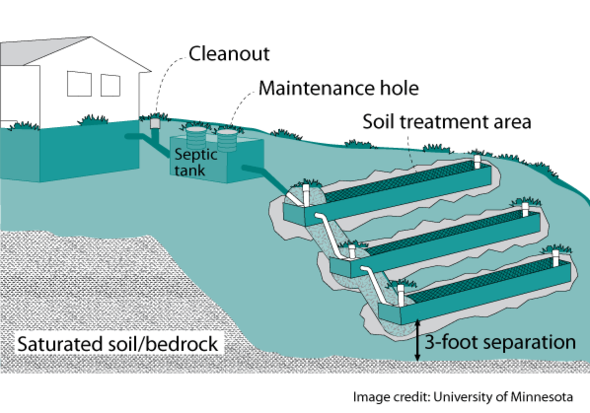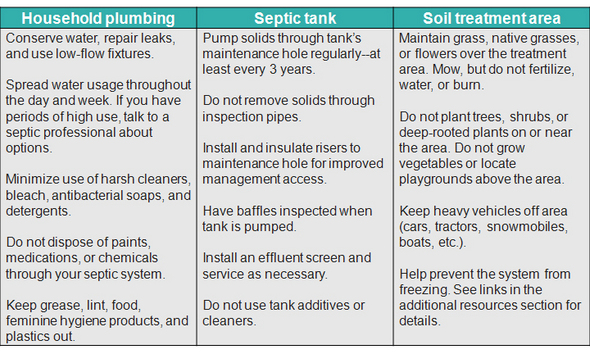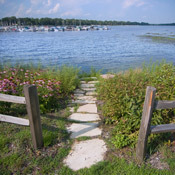|
If you own property along a shoreline, you have a unique opportunity to protect and improve the quality of Minnesota’s lakes and rivers. Here are two important things shoreline owners can do in 2013.
For those who don't own shoreline property, remember that you can still help our water in many ways. Try our ideas for your lawn and garden or volunteering. You can also make sure your local officials are aware of their responsibility to
protect public resources like our groundwater, lakes, and streams.
Residents in areas without access to public sewer systems maintain their own septic
systems. A poorly functioning septic system is a threat to human health
and the environment because it may not remove pathogens, nutrients, and
other chemicals from the used water before it enters our groundwater or
lakes.
Understand your system. A septic system has three parts:
household plumbing, a tank to collect sewage and solids, and a soil
treatment area. All three parts must be working to provide effective sewage
treatment.
 Don’t make assumptions. Many septic system owners
incorrectly assume that as long as their used water “goes away,” their
system must be working properly. Septic systems must
be designed specifically for your site’s conditions and installed correctly. Only regular
maintenance and evaluation of the system can ensure
that it is actually treating your sewage.
Look for symptoms of a poorly functioning septic system. These
include a pipe that goes directly to the lake or
ground (even
laundry water!), sewage surfacing in the
yard or a ditch, sewage odors, high levels of nitrates or coliform
bacteria in well water tests, or algae blooms and excessive plant growth
in nearby ponds or lakes.
Manage your system. These operation and maintenance guidelines will prevent costly repairs or premature replacement of your septic system.
 Hire a licensed professional to help you. The MPCA maintains a list of professionals currently licensed by the state
to conduct this specialized work. Interview your septic system
professional and learn about how they do business. Make sure they are
licensed, reputable, and reliable by asking for and checking references.
Additional resources:
 A natural shoreline will protect the bank from erosion,
catch and filter run off from the yard, provide shade over shallow
water, create habitat, and add beauty. Because of these benefits,
natural shorelines reduce nutrient pollution and algae blooms in your
lake too!
Creating a natural shoreline doesn’t mean
cutting out recreational uses or a view from the deck, but it does mean
that you’ll intentionally decide how and where you should increase the
number of trees, shrubs, grasses, and flowers on your lot. A natural
Minnesota shoreline may include a mix of live and dead trees, shrubs,
wildflowers, grasses, and rocks. Some shorelines have natural sand
covering most or a portion of the site.
Make a plan. The Minnesota DNR has an online tool called Restore your Shore that steps you through the entire process.
Look for assistance. Residents and cabin owners should inquire about available assistance from their local lake association or watershed district.
Additional resources:
|
 .
Join Northland Bioneers
and Do It Green! Minnesota for free showings of recorded keynote presentations from the 2012 Bioneers Conference, January 16, February 27, March 20, April 17, May 15, and June 19, potluck and networking at 6:30 p.m. and films at 7 p.m., Midtown Global Market lower level conference room (Minneapolis).
Consider new ideas for your lawn at the Minnesota Landscape Arboretum's Sustainable Yard series. Topics include lawn and turf, perennials, trees and shrubs, and the edible landscape. January 26 and February 2, 9, &16, 1-2:30 p.m. (Chaska).
The University of Minnesota's Institute on the Environment is hosting a free lecture series this spring. The next presentation is about natural gas hydraulic fracturing--also known as fracking, February 13, noon-1 p.m., U of M Learning and Environmental Science building (St. Paul).
The
CERTs 2013 Conference: Community-Driven Clean Energy will be an exploration and celebration
of successful energy efficiency and renewable energy projects, and a coming
together of hundreds of amazing people who are working to create a clean energy
future in their communities and beyond, February 21-22, River's Edge Convention Center (St. Cloud).
Thank you for reading Living Green 365. This newsletter is a publication of the Minnesota Pollution Control Agency. Please send questions or comments about living green to the address below.
Sincerely,
Britt Gangeness and the Living Green Team
livinggreen365.pca@state.mn.us
|